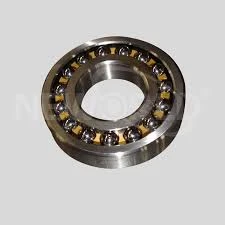
Oct . 02, 2024 11:35 Back to list
Understanding Axial Load Capacity in Spherical Roller Bearings for Enhanced Performance
Spherical Roller Bearings and Axial Load A Comprehensive Overview
Spherical roller bearings are designed to accommodate both radial and axial loads, making them a critical component in various applications across multiple industries. With their unique design featuring two rows of spherical rollers, these bearings can handle misalignment and provide enhanced performance. Understanding how spherical roller bearings manage axial loads is essential for engineers and technicians aiming to optimize machinery reliability and efficiency.
Structure and Design
The spherical roller bearing consists of an outer ring with a spherical raceway, an inner ring, and two rows of barrel-shaped rollers. This design enables the rollers to freely adjust and maintain contact with the raceway, accommodating misalignments due to shaft deflections and mounting errors. The ability to handle oscillating and tilting movements makes spherical roller bearings particularly suitable for heavy-duty applications.
Load Capacity
One of the key advantages of spherical roller bearings is their ability to support substantial axial loads in both directions. The axial load capacity of these bearings is primarily derived from the contact angle between the rollers and the raceway. This angle influences the distribution of forces within the bearing and is crucial in applications where axial loads are significant.
The axial load capacity is also affected by several design parameters, including the number of rollers, the roller profile, and the size of the bearing. Larger bearings with more rollers can support higher axial loads, while the shape of the rollers helps create a greater contact area, distributing the load more evenly.
Applications and Industries
Spherical roller bearings are widely used in various industries such as mining, construction, and manufacturing. They are common in applications where heavy loads and harsh operating conditions are present, including
1. Crushers and Mills In the mining industry, spherical roller bearings support large rotating components subjected to heavy radial and axial loads. 2. Heavy Machinery Construction equipment, such as bulldozers and excavators, frequently employs spherical roller bearings in their drive systems, where they endure high axial forces.
spherical roller bearing axial load

Importance of Proper Lubrication
To ensure optimal performance and extend the service life of spherical roller bearings under axial loads, proper lubrication is vital. Lubricants reduce friction and wear between the bearing components, helping to dissipate heat and protect against corrosion. Depending on the application, different types of lubricants—such as grease or oil—may be employed. Regular monitoring and maintenance of lubrication are crucial for preventing premature failure and maximizing bearing life.
Challenges and Considerations
When designing systems utilizing spherical roller bearings, engineers must consider various factors that can impact the bearing's performance under axial load. These include
- Misalignment While spherical roller bearings can compensate for misalignment, excessive misalignment can adversely affect their life and performance. Ensuring proper mounting and alignment is vital.
- Operating Conditions Environmental factors such as temperature, humidity, and exposure to contaminants can influence bearing performance. Selecting the right materials and seals can mitigate these effects.
- Load Dynamics Understanding the load dynamics involved in a specific application is essential for selecting the appropriate bearing size and type. Engineers must calculate the expected axial and radial loads accurately to avoid under- or over-sizing the bearings.
Conclusion
Spherical roller bearings play a pivotal role in managing axial loads across a wide range of applications. Their robust design allows for high load capacities and the ability to accommodate misalignments, making them essential in industries that operate in challenging environments. By understanding the factors influencing their performance, including proper lubrication and alignment, engineers can ensure optimal functionality, reliability, and longevity of machinery equipped with these vital components.
Latest news
-
Grooved Ball Bearing Design and Functionality
NewsJun.04,2025
-
Concrete Mixer Bearing Load Capacity Testing
NewsJun.04,2025
-
6004 Bearing Dimensions in Robotic Joint Designs
NewsJun.04,2025
-
Advantages of Single-Row Deep Groove Ball Bearings
NewsJun.04,2025
-
Applications of Deep Groove Ball Bearings in Automotive Systems
NewsJun.04,2025
-
Innovations in Bearing Pressing Machine Design
NewsJun.04,2025
